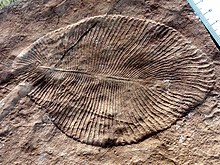| Proarticulata Temporal range: Late Ediacaran, between
| |
|---|---|

| |
| Fossil of Dickinsonia costata | |

| |
| Fossil of Spriggina | |
| Scientific classification | |
| Domain: | Eukaryota |
| Kingdom: | Animalia |
| Phylum: | †Proarticulata Fedonkin, 1985 |
| Classes and families | |
For more taxa, see text | |
Proarticulata is a proposed phylum of extinct, near-bilaterally symmetrical animals known from fossils found in the Ediacaran (Vendian) marine deposits, and dates to approximately 567 to 550 million years ago.[1][2] The name comes from the Greek προ (pro-) = "before" and Articulata, i.e. prior to animals with true segmentation such as annelids and arthropods. This phylum was established by Mikhail A. Fedonkin in 1985 for such animals as Dickinsonia, Vendia, Cephalonega, Praecambridium[3] and currently many other Proarticulata are described (see list).[4][5]
Due to their simplistic morphology, their affinities and mode of life are subject to debate. They are almost universally considered to be metazoans, and due to possessing a clear central axis have been suggested to be stem-bilaterians. In the traditional interpretation, the Proarticulatan body is divided into transverse articulation (division) into isomers as distinct from the transverse articulation segments in annelids and arthropods, as their individual isomers occupy only half the width of their bodies, and are organized in an alternating pattern along the longitudinal axis of their bodies.[5] In other words, one side is not the direct mirror image of its opposite (chirality). Opposite isomers of left and right side are located with displacement of half of their width. This phenomenon is described as the symmetry of gliding reflection.[6][7] Some recent research suggests that some proarticulatans like Dickinsonia have genuine segments, and the isomerism is superficial and due to taphonomic distortion.[8] However, other researchers dispute this.[9][10] Displacement of left-right axis is known in bilaterians, notably lancelets.[11][12]
- ^ Maslov AV, Podkovyrov VN, Grazhdankin DV, Kolesnikov AV (2018). "Upper Vendian in the east, northeast and north of East European Platform: Depositional processes and biotic evolution". Litosfera. 18 (4): 520–542. doi:10.24930/1681-9004-2018-18-4-520-542.
- ^ Kolesnikov AV, Liu AG, Danelian T, Grazhdankin DV (2018). "A reassessment of the problematic Ediacaran genus Orbisiana Sokolov 1976". Precambrian Research. 316: 197–205. Bibcode:2018PreR..316..197K. doi:10.1016/j.precamres.2018.08.011. S2CID 134213721.
- ^ Fedonkin MA (1985). "Systematic Description of Vendian Metazoa". In Sokolov BS, Iwanowski AB (eds.). Vendian System: Historical–Geological and Paleontological Foundation. Vol. 1: Paleontology. Moscow: Nauka. pp. 70–106.
- ^ Fedonkin MA (31 March 2003). "The origin of the Metazoa in the light of the Proterozoic fossil record" (PDF). Paleontological Research. 7 (1): 9–41. doi:10.2517/prpsj.7.9. S2CID 55178329.
- ^ a b Ivantsov AY, Fedonkin MA, Nagovitsyn AL, Zakrevskaya ZA (2019). "Cephalonega, a new generic name, and the system of Vendian Proarticulata". Paleontological Journal. 53 (5): 447–454. doi:10.1134/S0031030119050046. S2CID 203853224.
- ^ Cite error: The named reference
Ivantsov2001was invoked but never defined (see the help page). - ^ Cite error: The named reference
Ivantsov1999was invoked but never defined (see the help page). - ^ Dunn FS, Liu AG, Donoghue PC (May 2018). "Ediacaran developmental biology". Biological Reviews of the Cambridge Philosophical Society. 93 (2): 914–932. doi:10.1111/brv.12379. PMC 5947158. PMID 29105292.
- ^ Ivantsov AY, Zakrevskaya MA, Nagovitsyn AL (June 2019). "Morphology of integuments of the Precambrian animals, Proarticulata". Invertebrate Zoology. 16 (1): 19–26. doi:10.15298/invertzool.16.1.03.
- ^ Ivantsov Y, Fedonkin MA, Nagovitsyn AL, Zakrevskaya MA (September 2019). "Cephalonega, A New Generic Name, and the System of Vendian Proarticulata". Paleontological Journal. 53 (5): 447–454. doi:10.1134/s0031030119050046. S2CID 203853224.
- ^ Blum M, Feistel K, Thumberger T, Schweickert A (April 2014). "The evolution and conservation of left-right patterning mechanisms". Development. 141 (8): 1603–13. doi:10.1242/dev.100560. PMID 24715452.
- ^ Soukup V (2017). "Left-right asymmetry specification in amphioxus: review and prospects". The International Journal of Developmental Biology. 61 (10–11–12): 611–620. doi:10.1387/ijdb.170251vs. PMID 29319110.